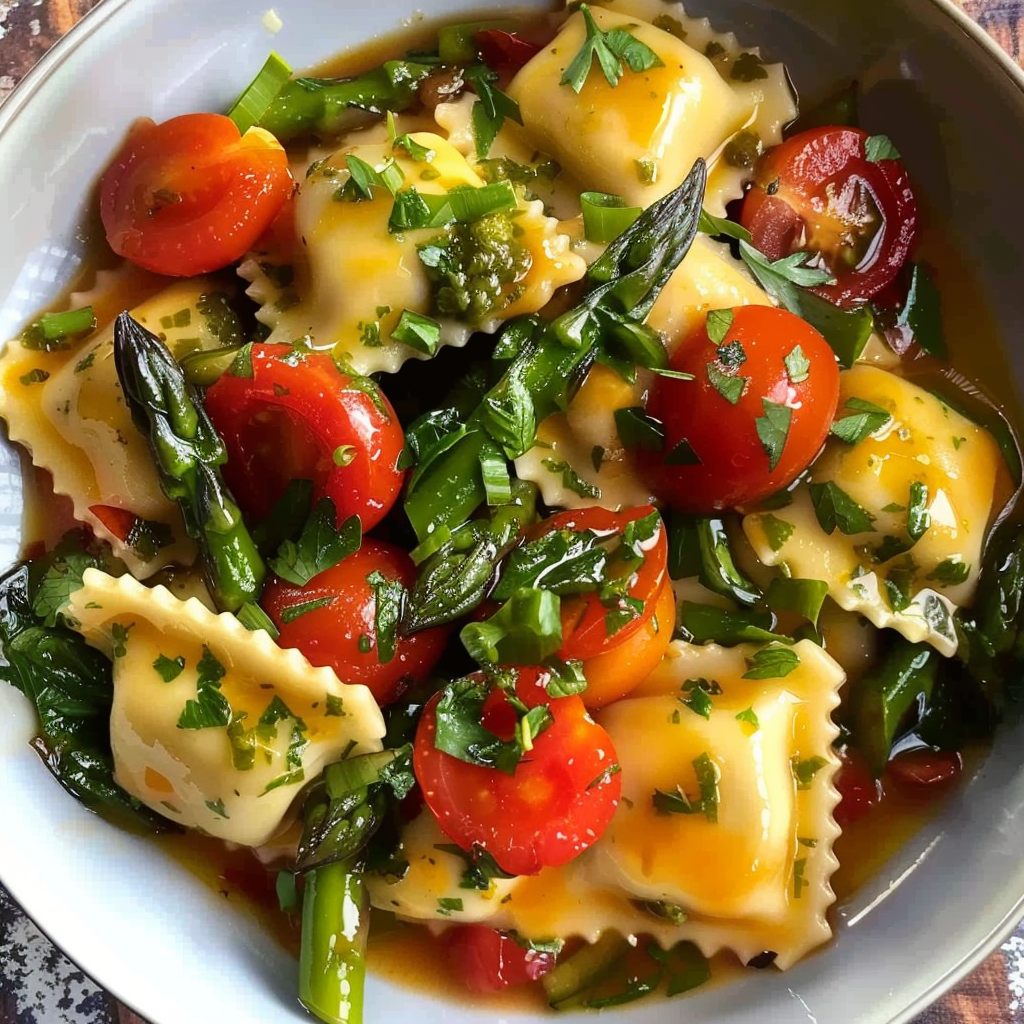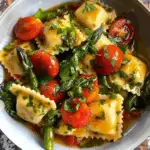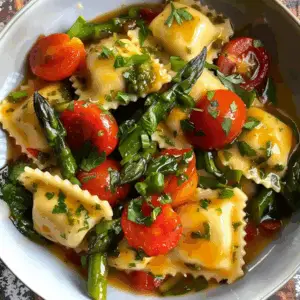Why This Ravioli Recipe Works
If you’re looking for a flavorful, easy ravioli recipe that brings together seasonal vegetables and fresh herbs in under 30 minutes, this ravioli with tomatoes, asparagus, garlic, and herbs is your answer. It’s a weeknight dinner hero that feels restaurant-worthy—bright, savory, and satisfyingly simple. The combination of tender cheese ravioli, lightly sautéed cherry tomatoes, crisp-tender asparagus, and the deep aroma of garlic creates a layered flavor profile with minimal effort.
Unlike traditional creamy ravioli dishes, this recipe skips the heavy sauces in favor of a light, olive oil-based pan sauce that lets the ingredients shine. The addition of fresh basil and parsley just before serving adds a burst of herbal brightness, making the dish feel both fresh and comforting. This method borrows inspiration from classic Italian vegetable pasta dishes, using the natural juices of the tomatoes and a hint of pasta water to build a glossy, emulsified sauce that coats every bite of ravioli.
Using ingredients like Parmesan cheese and garlic not only enhances umami but ties the dish to traditional Mediterranean cooking. According to Wikipedia, ravioli originated as a way to transform simple, humble fillings into something rich and celebratory. This modern take maintains that spirit while streamlining the process for busy home cooks. For more easy pasta dinner ideas, check out curated options on Pinterest, where vegetable-forward recipes are trending as both nutritious and flavorful solutions.
Whether you’re looking to impress guests or just want a fast, wholesome meal, this cheese ravioli with vegetables recipe delivers big flavor without stress.
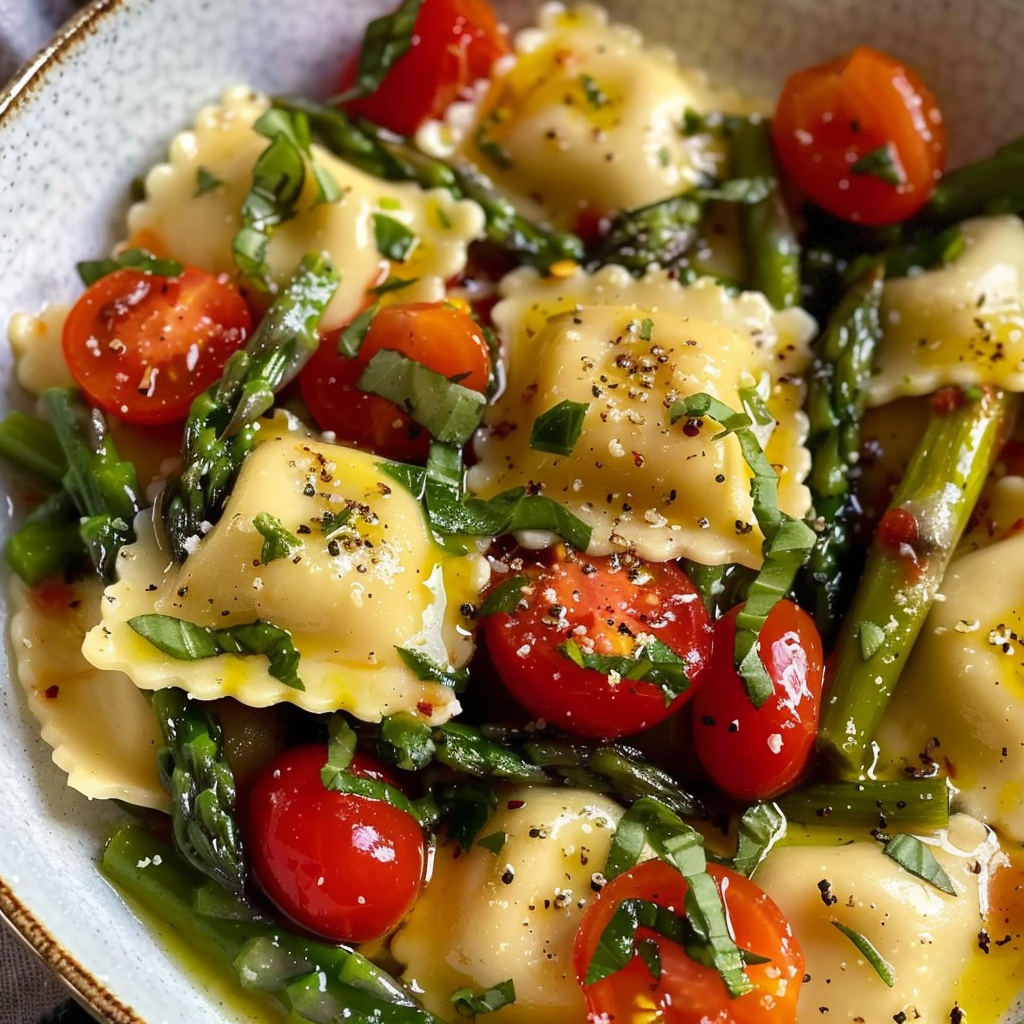
Ingredients Overview: What You’ll Need
This ravioli and asparagus recipe is built on a short list of fresh, accessible ingredients that deliver maximum flavor with minimal prep. Each component plays a key role in creating a well-balanced dish, and with a few smart substitutions, it can easily adapt to suit your taste or dietary preferences.
Here’s a breakdown of what you’ll need and why each ingredient matters:
-
Cheese Ravioli (9–12 oz, refrigerated)
The creamy filling of cheese ravioli offers richness that complements the brightness of the vegetables. Choose refrigerated ravioli for quicker cooking and better texture. Frozen or homemade ravioli also work, but may require adjusted cooking times. For more about ravioli varieties, Wikipedia offers a detailed look into regional differences and fillings. -
Olive Oil (1 tablespoon)
A good-quality olive oil forms the base of the sauce, helping to sauté the garlic and coat the pasta. As a staple of the Mediterranean diet, olive oil also enhances the dish’s nutritional value. Learn more about its culinary uses on Wikipedia. -
Cherry or Grape Tomatoes (2 cups, halved)
When sautéed, cherry tomatoes burst to create a natural sauce that’s both sweet and tangy. Their juices help bind the ingredients without the need for cream. For a deeper understanding of this ingredient, visit Wikipedia. -
Asparagus (1 bunch, trimmed and cut into 2-inch pieces)
Asparagus adds a crisp bite and earthy flavor, balancing the softness of the ravioli. In-season asparagus is best, but frozen can be used in a pinch. Check out Wikipedia to learn more about its seasonal availability and nutritional profile. -
Garlic (3 cloves, minced)
Essential for the base flavor, garlic is sautéed briefly to infuse the oil. Mincing releases more flavor than slicing, ensuring each bite carries that unmistakable aromatic note. You can read about its global culinary significance on Wikipedia. -
Red Pepper Flakes (¼ tsp, optional)
This adds a gentle kick without overwhelming the other flavors. It’s optional, but recommended for those who enjoy a bit of heat. -
Salt and Black Pepper (to taste)
Seasoning at each stage is crucial to enhance the natural flavors of the vegetables and pasta. -
Fresh Basil and Parsley (1 tbsp each, chopped)
These culinary herbs brighten the dish and add color. Basil gives it a sweet, slightly peppery note, while parsley contributes a clean finish. For more about their uses in cooking, visit Wikipedia. -
Grated Parmesan Cheese (for serving)
Sprinkling Parmesan cheese on top adds salty depth and a finishing touch of richness. Parmigiano Reggiano is preferred, but any aged hard cheese works well.
For those exploring vegetarian pasta recipes, this dish offers a versatile foundation. You can browse similar ideas on Pinterest for inspiration on ingredient variations or additions.
With these ingredients in hand, you’re ready to start building a simple, elegant meal that’s full of flavor.
How to Prep the Vegetables for Maximum Flavor
Prepping your vegetables properly is the key to unlocking the maximum flavor in this ravioli and asparagus recipe. The steps are quick, but they matter—especially when you’re working with fresh, seasonal ingredients. Well-prepped vegetables sauté more evenly, release their natural juices, and build a more cohesive dish.
Here’s how to get the most out of your ingredients before they hit the pan:
-
Trim the Asparagus Correctly
Snap off the woody ends by bending each stalk gently until it breaks—this natural breaking point ensures you’re using only the tender parts. Then, slice the stalks into 2-inch pieces for even cooking and easy bites. As explained in this Wikipedia article, asparagus is highly seasonal and best when crisp-tender. -
Halve the Cherry Tomatoes
Slice the cherry or grape tomatoes lengthwise to expose their juicy interiors. This not only helps them break down into a sauce more quickly but also ensures they release their sweet-tart flavor into the pan. As noted in the Wikipedia entry on cherry tomatoes, smaller tomatoes offer more concentrated flavor, ideal for fast cooking. -
Mince the Garlic for Stronger Flavor Release
While some recipes call for sliced garlic, mincing it ensures it cooks faster and distributes more evenly in the oil. This is essential for infusing the base of your dish with that unmistakable garlic aroma and flavor. You’ll find garlic at the heart of many classic Italian and Mediterranean pasta dishes. -
Chop Herbs Just Before Cooking
For the basil and parsley, wait until just before you’re ready to toss them in. Herbs lose their aromatic oils quickly, so chopping them fresh ensures they deliver their full flavor impact. For best results, use a sharp knife and avoid bruising the leaves. -
Set Everything in Bowls or Prep Trays
To cook efficiently, place each prepped ingredient into separate bowls. This mise en place method lets you move smoothly from step to step, especially helpful in a dish that comes together in under 30 minutes.
Proper prep ensures that each ingredient performs as it should in the skillet—the asparagus stays crisp, the tomatoes break down just enough to form a light sauce, and the garlic perfumes the oil without burning. These small details make a big difference in a one-pan recipe like this.
How to Cook Ravioli Without Overcooking It
Cooking ravioli might seem straightforward, but getting it just right can make the difference between a perfect bite and a mushy mess. Since cheese ravioli is the heart of this recipe, handling it properly ensures a light, delicate texture that pairs beautifully with the fresh vegetables and herbs.
Follow these key steps to avoid overcooked, broken ravioli:
-
Follow Package Directions Exactly
Different brands of refrigerated ravioli vary in thickness and filling density. Most cook in 3–5 minutes, so pay close attention to the suggested time. Overcooking will cause them to burst or become soggy, losing their creamy texture. -
Watch for Surface Bloating and Floating
Ravioli is done when it floats to the surface and appears slightly puffed. This indicates the filling is hot and the pasta has reached the ideal tenderness. Avoid cooking past this point. -
Salt the Water Generously
Just like any pasta dish, salted water enhances flavor. Aim for about 1 tablespoon of salt per 4 quarts of water. This small step brings out the subtle taste of the cheese filling and balances the acidity of the tomatoes. -
Stir Gently and Only Once or Twice
When you first drop ravioli into boiling water, give them a gentle stir to prevent sticking. After that, let them cook undisturbed—too much agitation can cause tearing. -
Drain Without Rinsing
Once cooked, drain the ravioli using a slotted spoon or mesh strainer, and do not rinse. The light coating of starch helps bind the olive oil-based pan sauce to the pasta. This method is common in many Italian pasta preparations, as detailed in Wikipedia’s pasta overview. -
Handle with Care
Use a large spoon or silicone spatula to transfer ravioli from the colander to the skillet. This prevents them from breaking apart during the toss with the vegetables.
Cooking ravioli to just the right texture helps the dish maintain its structure and flavor integrity. If you’re browsing for similar vegetarian pasta recipes, you’ll notice that success often comes down to proper timing—whether you’re making mushroom ravioli or variations with butternut squash, texture is everything. For more ideas, explore Pinterest’s collection of vegetarian pasta recipes where techniques like these are key to success.
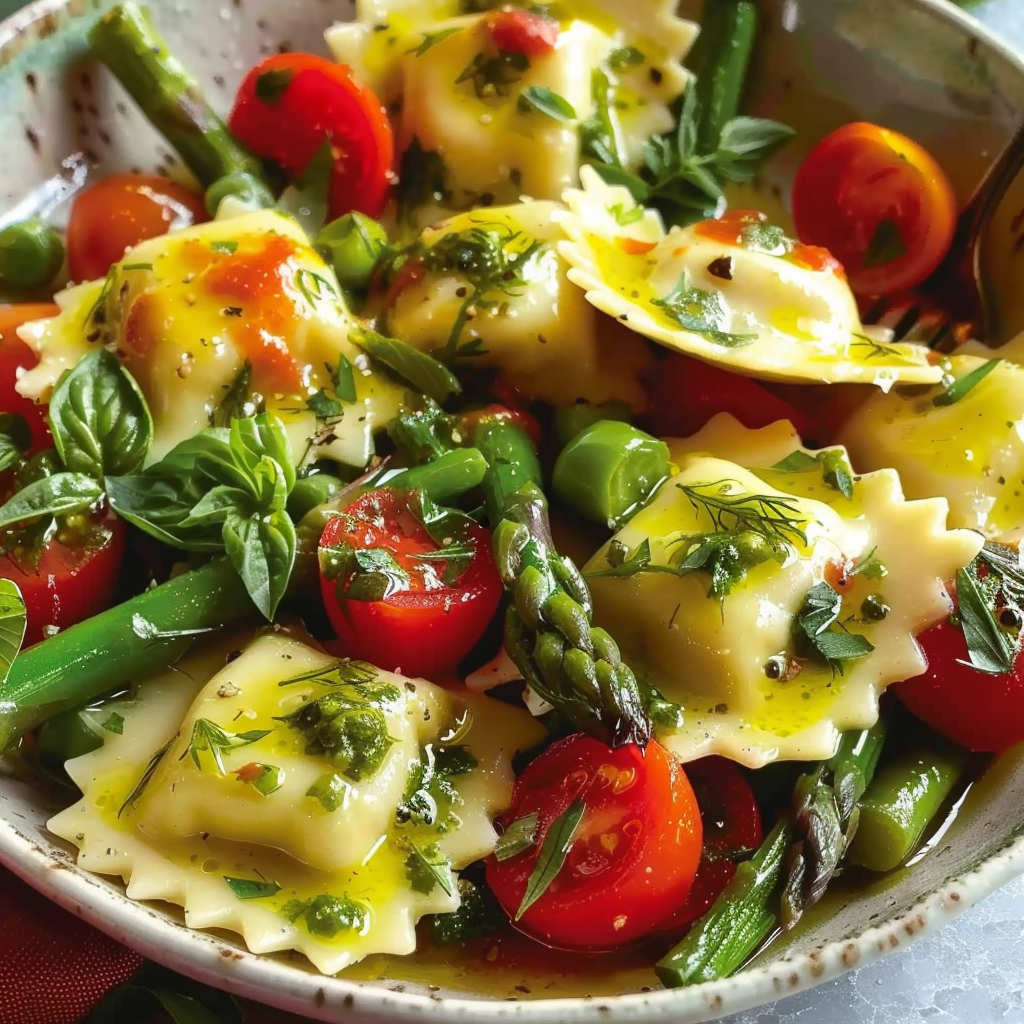
The Key to a Glossy Pan Sauce Without Cream
A standout feature of this ravioli with asparagus and tomatoes recipe is its light but flavorful sauce—made without cream. Instead of relying on heavy dairy, the sauce builds from a smart combination of sautéed vegetables, olive oil, and a touch of pasta water. This technique creates a glossy, emulsified sauce that clings perfectly to every piece of ravioli.
Here’s how to achieve it:
-
Let the Tomatoes Do the Work
As the cherry tomatoes cook in the pan, they soften and release their natural juices. This liquid forms the foundation of the sauce. It blends with the olive oil to create a velvety texture that’s both fresh and savory. -
Don’t Drain All the Pasta Water
Reserve about ¼ cup of pasta cooking water before draining the ravioli. This starchy water is essential—it helps the sauce cling to the ravioli and binds everything together. This trick is widely used in Italian pasta recipes for a reason. -
Emulsify by Tossing, Not Stirring
Once the ravioli is added to the skillet, toss gently over low heat. The motion encourages the olive oil, tomato juice, and pasta starch to emulsify into a light sauce. Avoid aggressive stirring to keep the ravioli intact. -
Optional Flavor Boosters
If you want to deepen the flavor without cream, add:-
A splash of white wine to the pan after the garlic and tomatoes have sautéed
-
A squeeze of lemon juice for brightness
-
A few ribbons of Parmesan cheese stirred in while the pasta is still hot
-
This method results in a dish that’s light but still comforting—a great fit for anyone looking to avoid heavy sauces without sacrificing flavor. You’ll often see similar techniques in Mediterranean recipes, especially those focused on seasonal vegetables and heart-healthy ingredients like olive oil, highlighted in this Wikipedia entry.
Sautéing Vegetables for Texture and Flavor
In this one-pan dish, the asparagus and cherry tomatoes take center stage alongside the ravioli. Cooking them correctly ensures the right balance of softness and bite—giving your meal both freshness and depth.
Here’s how to get perfect results:
-
Start with Garlic
Heat olive oil over medium heat and sauté the minced garlic for 30 seconds, just until fragrant. This step infuses the oil with flavor, laying the foundation for everything that follows. -
Add Tomatoes and Asparagus at the Right Time
After the garlic, add the halved cherry tomatoes and trimmed asparagus at the same time. Cook for 5–7 minutes, stirring occasionally. This allows:-
Tomatoes to blister and release juice
-
Asparagus to stay crisp-tender without turning mushy
-
-
Don’t Overcrowd the Pan
Use a large skillet so the vegetables can cook in a single layer. Overcrowding causes steaming instead of sautéing, which affects texture and flavor. -
Season While Cooking
Sprinkle in salt, black pepper, and red pepper flakes if using. Seasoning during cooking helps draw moisture from the tomatoes and enhances the flavor base. -
Finish with Herbs Off Heat
Once the ravioli is tossed in and heated through, turn off the heat before adding the fresh basil and parsley. This preserves their vibrant color and delicate flavor.
This careful sauté process highlights the natural taste of each vegetable while contributing to the sauce. For more on using vegetables as a flavor base in pasta, you can check out Wikipedia’s article on culinary herbs, which explains how herbs enhance dishes without overpowering.
Step-by-Step Cooking Instructions
This ravioli with tomatoes, asparagus, garlic, and herbs recipe comes together quickly in one pan. Follow these exact steps for success every time:
-
Cook the Ravioli
-
Boil a large pot of salted water
-
Add refrigerated cheese ravioli
-
Cook until they float and are tender (3–5 minutes)
-
Reserve ¼ cup pasta water, then drain and set aside
-
-
Sauté Garlic
-
In a large skillet, heat 1 tablespoon olive oil over medium
-
Add 3 minced garlic cloves
-
Cook for 30 seconds until fragrant
-
-
Add Vegetables
-
Add 2 cups halved cherry tomatoes and 1 bunch asparagus (cut into 2-inch pieces)
-
Season with salt, black pepper, and optional red pepper flakes
-
Sauté for 5–7 minutes, stirring occasionally
-
-
Add Ravioli & Combine
-
Add cooked ravioli to the skillet
-
Drizzle in reserved pasta water
-
Toss gently to coat everything in the sauce
-
-
Finish with Fresh Herbs
-
Turn off heat
-
Stir in 1 tablespoon each of chopped fresh basil and parsley
-
-
Serve
-
Plate immediately
-
Top with grated Parmesan cheese
-
This quick-cooking method is perfect for a weeknight meal and reflects the smart techniques used in vegetarian pasta recipes on Pinterest, where simplicity meets big flavor.
What to Serve with This Ravioli Dish
This ravioli and asparagus meal is complete on its own, but pairing it with the right sides and drinks can turn it into an elegant dinner.
Here are some easy, delicious serving ideas:
-
Crusty Bread or Garlic Toast
Ideal for soaking up the tomato-herb sauce. Baguette slices, garlic toast, or even focaccia work beautifully. -
Light Green Salad
A simple arugula or mixed greens salad with a lemon vinaigrette keeps the meal fresh and balanced. -
Wine Pairing
-
Pinot Grigio or Sauvignon Blanc offers a crisp contrast to the warm, savory pasta.
-
For a red option, try a light Chianti.
-
-
Non-Alcoholic Option
Sparkling water with a slice of lemon or cucumber refreshes the palate between bites.
You’ll find similar pairings in other pasta dinner ideas, like those on Pinterest, where simple vegetable-based dishes are often paired with bright, clean flavors for contrast.
Storage and Reheating Tips
Got leftovers? This ravioli with vegetables stores and reheats well, with a few simple tips:
-
Refrigeration
-
Store in an airtight container
-
Refrigerate for up to 3 days
-
-
Reheating
-
For best texture, reheat in a skillet over medium heat
-
Add a splash of water or olive oil to loosen the sauce
-
Alternatively, microwave in short bursts (30–45 seconds), stirring gently
-
-
Freezing
-
Not recommended due to asparagus and tomato texture changes
-
However, cooked ravioli can be frozen separately and reheated in sauce
-
By handling leftovers properly, you’ll preserve the flavor and integrity of the dish for another satisfying meal.
Customizations and Variations
This easy ravioli recipe is highly flexible. You can adjust it to suit your pantry, dietary needs, or seasonal ingredients.
Here are some tasty variations:
-
Add Protein
-
Grilled chicken or shrimp
-
Crisped pancetta or prosciutto
-
-
Extra Veggies
-
Sautéed mushrooms, zucchini, or spinach
-
Sun-dried tomatoes for an umami boost
-
-
Vegan Option
-
Use plant-based vegan ravioli and skip the Parmesan
-
Add nutritional yeast or vegan cheese shreds for flavor
-
-
Flavor Enhancers
-
Zest of 1 lemon for brightness
-
A drizzle of balsamic glaze before serving
-
This customization makes the recipe perfect for rotating through seasons or tailoring to your preferences.
Common Mistakes to Avoid
Even simple recipes can go wrong with a few missteps. Here’s what to watch for:
-
Overcooking the Ravioli
Cook just until tender—overdone ravioli turns mushy or may break apart. -
Skipping the Pasta Water
It’s crucial for creating a light sauce that clings. -
Overcrowding the Pan
This leads to steaming, not sautéing. Use a large skillet. -
Burning the Garlic
Garlic cooks fast—30 seconds is enough. Burned garlic adds bitterness. -
Adding Herbs Too Early
Fresh herbs should go in after the heat is off to preserve color and flavor.
Avoiding these mistakes ensures a restaurant-quality result every time.
Nutrition Information (Optional Section)
Here’s an estimated breakdown for one serving (based on 4 servings total):
-
Calories: 420
-
Protein: 15g
-
Carbs: 48g
-
Fat: 18g
-
Fiber: 5g
-
Sodium: 580mg
Nutrition may vary depending on ravioli brand and cheese used.
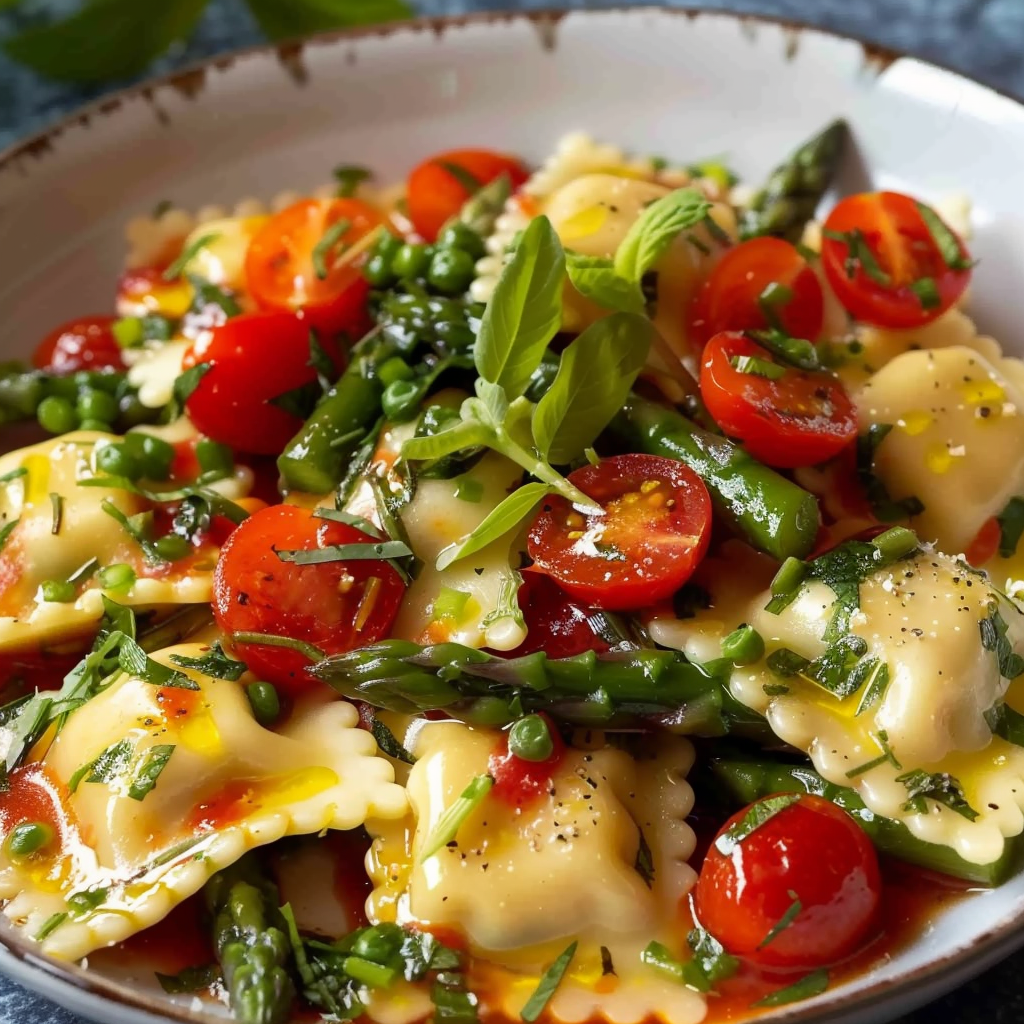
FAQs: Ravioli with Vegetables and Herbs
Can I use frozen ravioli instead of refrigerated?
Yes, but adjust cooking time according to package instructions. Frozen ravioli may need 2–3 minutes more.
What other vegetables go well with ravioli?
Zucchini, mushrooms, spinach, and bell peppers all pair beautifully with cheese ravioli.
How do I prevent ravioli from sticking together?
Stir gently during cooking and avoid rinsing after draining. Toss immediately with oil or sauce.
Can I make this recipe ahead of time?
It’s best served fresh, but you can prep ingredients and cook the ravioli ahead. Reheat gently with a splash of water.
What herbs pair best with ravioli and tomatoes?
Fresh basil and parsley are ideal. You can also use thyme, oregano, or chives for variety.
Is this ravioli dish healthy?
Yes, especially when compared to cream-based pasta dishes. It’s lighter, rich in vegetables, and balanced with protein and carbs.
Ravioli Recipe With Tomatoes Asparagus Garlic And Herbs
A quick and vibrant cheese ravioli recipe with sautéed cherry tomatoes, asparagus, garlic, and fresh herbs. Finished with Parmesan cheese and a light olive oil-based sauce, this one-pan pasta dish is perfect for busy weeknights or casual dinner parties. Fast, fresh, and full of flavor.
- Author: Clara
Ingredients
- 1 package (about 9–12 oz) refrigerated cheese ravioli
- 1 tablespoon olive oil
- 2 cups cherry or grape tomatoes, halved
- 1 bunch asparagus, trimmed and cut into 2-inch pieces
- 3 garlic cloves, minced
- 1/4 teaspoon red pepper flakes (optional)
- Salt and black pepper to taste
- 1 tablespoon fresh basil, chopped
- 1 tablespoon fresh parsley, chopped
- Grated Parmesan cheese, for serving
Instructions
Cook the ravioli according to package directions. Drain and set aside.
In a large skillet, heat olive oil over medium heat. Add garlic and sauté for about 30 seconds until fragrant.
Add tomatoes and asparagus to the skillet. Season with salt, black pepper, and red pepper flakes if using. Cook for 5–7 minutes, stirring occasionally, until the vegetables are tender and tomatoes are soft.
Add the cooked ravioli to the skillet and toss gently to combine with the vegetables.
Remove from heat and stir in fresh basil and parsley.
Serve warm, topped with grated Parmesan cheese.
Notes
-
Use refrigerated ravioli for faster cooking
-
Don’t skip the reserved pasta water—it’s key to the sauce
-
Always add herbs at the end to keep their flavor fresh
-
Optional: Add a splash of white wine to deepen the sauce
-
Best served immediately but can be stored for up to 3 days in the fridge
